
 |
|
|
|
|
Microbial Mat Features in Mudstones & Shales
 |
Microbial mat deposits are rarely reported from mud accumulating environments, yet modern mats nonetheless colonize muddy sediment surfaces. The sedimentary features that result from microbial mat colonization may be subtle, but their recognition is essential for properly interpreting ancient deposits. |
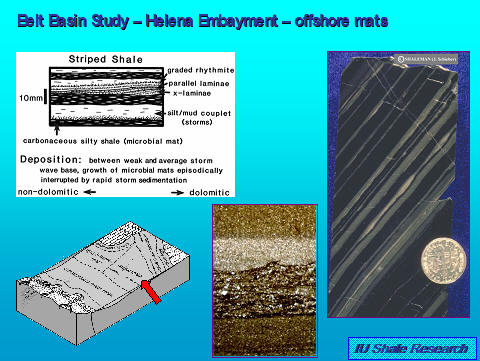 |
In the Proterozoic Belt Basin, microbial mats colonize offshore mud surfaces during quiescent interludes and attain (compacted) thicknesses of mm's to cm's. They are interbedded with distal muddy tempestites. The erosive events associated with storm deposition are infrequent, and interbedding of the two layer types gives these shales a striped appearance. |
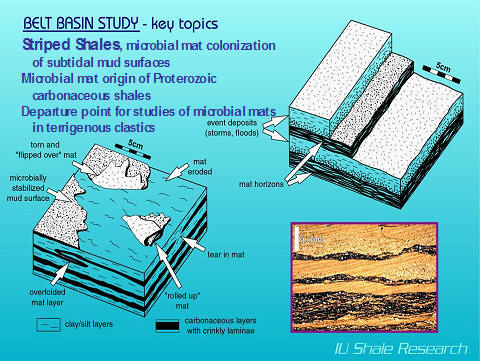 |
The recognition of "striped shales" in various other Mid-Proterozoic successions indicates that offshore benthic mats were a vital part of Proterozoic ecology and important for the formation of carbonaceous shales and potential source rocks. |
Photomicrograph of carbonaceous flakes (marked with A) in clayey shale bed (Belt Supergroup, Newland Formation). Flakes are contorted and contain more silt than the surrounding shale matrix. This suggests cohesive behavior during transport and trapping of silt grains on microbial films. Scale bar is 0.5 mm long. |
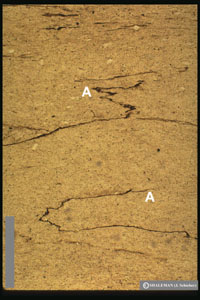 |
|
Reference for above: Schieber, J., 1986, The possible role of benthic microbial mats during the formation of carbonaceous shales in shallow Proterozoic basins: Sedimentology, v. 33, p. 521-536. download PDF file (left click on link and click on "Save as"...) |
|
 |
A pyritic sub-facies developed where iron-bearing waters were introduced along the shoreline and flocculated iron hydroxides were incorporated into the mats and transformed into pyrite. |
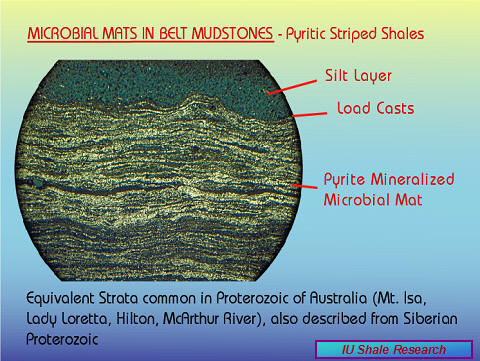 |
These pyritic striped shales are reactive host rocks for base-metal bearing solutions that pass through these rocks later on in geologic history. They may have been essential for localizing major Proterozoic base metal deposits, such as those at McArthur River and Mt. Isa. |
|
References for above: Schieber, J., 1989,
Pyrite mineralization in microbial mats from the Mid-Proterozoic
Newland Formation, Belt Supergroup, Montana, U.S.A.: Sedimentary
Geology, v. 64, p. 79-90.
Link |
|
 |
Microbial mats can also produce domal features on mud surfaces that resemble traditional stromatolites. Associated laminae are often variably dolomitic, probably reflecting small rates of terrigenous deposition as well as metabolic processes of the mat itself. |
 |
Greenish-gray Belt Basin shale with small stromatolitic domes. Location marked by white arrows. |
 |
In cases where overall terrigenous accumulation rates are somewhat higher, but where conditions are otherwise similar to above, dolomitic microbial laminae can still form. However, domal buildups are of low amplitude and more irregular. |
 |
Red Belt Basin shale with low amplitude microbial hummocks (white arrows). |
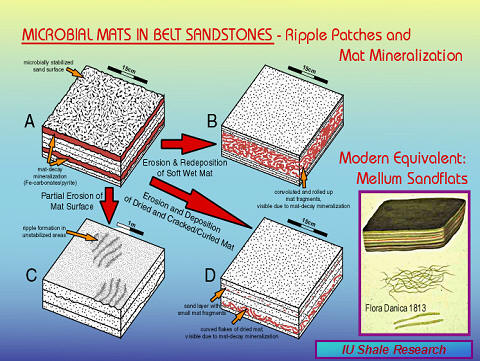 |
SANDSTONES: Microbial mats on sandy surfaces may not be preserved as distinct laminae, but their decay causes mineralization with ferroan carbonates and/or pyrite that outlines the former mats or mat fragments. |
|
References for above: Schieber, J., 1998,
Possible indicators of microbial mat deposits in shales and
sandstones: Examples from the Mid-Proterozoic Belt Supergroup,
Montana, U.S.A. Sedimentary Geology, v. 120, p. 105-124.
download
PDF file (left click on link and click on "Save as"...)
|
|
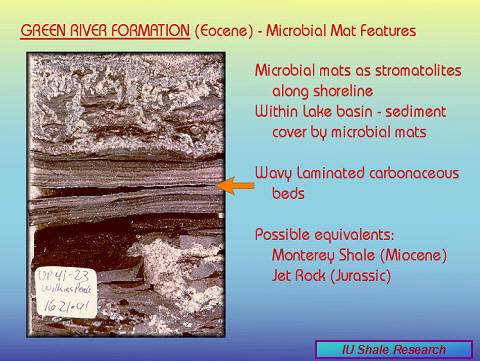 |
Layers of wavy carbonaceous laminae that resemble microbial mat laminae from the mudstones of the Belt Basin also occur in mudstones of the Green River Formation. |
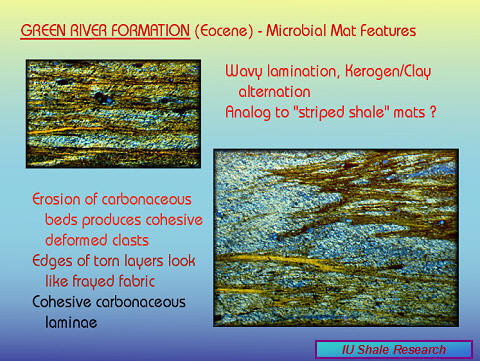 |
The suspected microbial laminae from Green River mudstones show evidence of internal cohesiveness during erosion and transport. These features are consistent with a microbial mat origin. |
|
References for above: Schieber, J., 1999,
Microbial Mats in Terrigenous Clastics: The Challenge
of Identification in the Rock Record. Palaios, v. 14, p.
3-12.
download PDF file (left click on link and
click on "Save as"...) |
|
 |
Enough said. |
|
|
|
| Back to SHALE RESEARCH LAB Main Page | |
| Back to IU Department of Geological Sciences | |
|
© Jürgen Schieber, IU Bloomington Department of
Geosciences Last updated: November 23, 2023. |
|